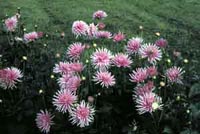Resource Library
Plant of the Week: Garden Dahlia
The University of Arkansas System Division of Agriculture does not promote, support or recommend plants featured in "Plant of the Week." Please consult your local Extension office for plants suitable for your region.
Plant of the Week
Garden Dahlia
Latin: Dahlia hybrida

Floral fashions are quirky and unpredictable, and like the stock market, easy to chart
but hard to predict.
The garden dahlia, since its introduction in European garden culture in the mid 18th
Century, has had many such rises and falls in popularity and I predict it is time
for another round of garden popularity for this old floral workhorse. With our new
found love affair with the "big and bold" look in the flower garden, dahlias seem
to fit in naturally.
Apparently the first introduction of the dahlia, a Mexican native in the sunflower
family, involved a bit of mid 18th Century stealth, chicanery and smuggling. Spain
forbid the live export of any of its New World natural products to other European
countries in an attempt to maintain a monopolistic hold on the markets. One of the
market items in demand was an insect that produced a red dye called cochineal. Apparently,
a Monsieur Menoville, a Frenchman attached to the embassy, sent back to France the
insects with a bunch of dahlia roots to serve as food.
The insects died but the roots arrived and were sent to Jardin du Roi. There, its
curator, André Thouin, grew the plant. Thouin saw the plant, not as a flower, but
as a possible fleshy rooted substitute for the potato. But the idea was never to catch
on because, according to one informed taste tester, dahlia roots have a "repulsive,
nauseous peppery taste which inspires equal disgust to man and beast." The plant slipped
out of sight for another quarter century.
Dahlias appear to have made their official garden debut when seeds were sent in 1789
from the Mexico City Botanic Garden by the curator, Vincente Cervantes, to his friend
Abbé Cavanilles, who was in charge of the Royal Gardens in Madrid. Cavanilles named
the new plant in honor of Anders Dahl, a Swedish botanist who had died just two years
earlier and had been trained by the famous botanist, Linnaeus. Seeds were then distributed
to other European gardens and the first dahlia craze began. By 1826 a prize of 1,000
pounds was offered in England for a blue-flowered dahlia.
By the 1850s, one New York dealer listed over 300 selections in his catalog. Since
then, there have been several rises and falls in dahlia popularity. It may just be
time for another spurt in popularity.
The fleshy dahlia tubers are not reliably hardy in most of Arkansas and must be lifted
each winter and stored where they will not freeze. Dahlias may also be grown from
seed and are often sold as spring bedding plants. If the tubers of these seedlings
are saved, they will be much taller the second year. Dahlias prefer fertile, well-watered
garden sites in full sun. They will have scattered blooms all summer long but their
peak blooming period is really the cooler days of fall.
Dahlias typically are big plants, often ranging from 3 to 5 feet tall. Flowers are
available in a wide array of pastel shades and may be small single affairs three inches
across to giants with blooms the size of a dinner plate. The stems of these big plants
tend to be brittle so some early season staking or caging may help keep plants upright
once the monstrous blooms begin appearing. They make excellent cut flowers.
By: Gerald Klingaman, retired
Extension Horticulturist - Ornamentals
Extension News - September 17, 1999
The University of Arkansas System Division of Agriculture does not maintain lists of retail outlets where these plants can be purchased. Please check your local nursery or other retail outlets to ask about the availability of these plants for your growing area.